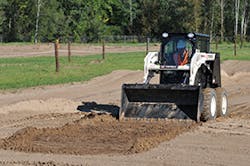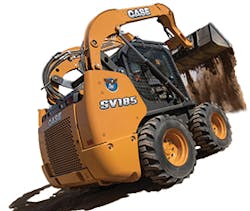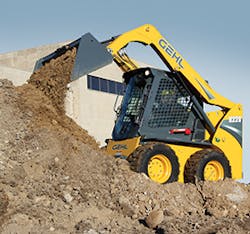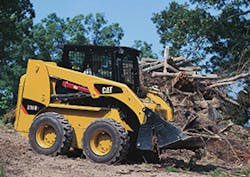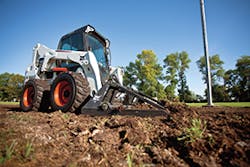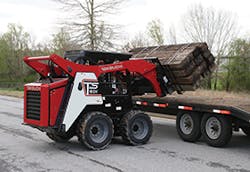Compact loaders have become the “all-round job-site machines,” points out Tonya Bair, vice president of operations for Bair Products. “One machine can perform more diverse applications on a single job site than many machines, in some circumstances, and can be used on large and small job sites,” she says. “They can be easily hauled behind a heavy-duty truck to reach many job sites in one day.”
There’s not a more versatile piece of construction equipment on a construction site than a skid-steer loader, points out Brian Rabe, manager of product development for Gehl equipment. “This work tool can have between five attachments during the course of a day to 20 in some extreme applications,” he says.
Many factors should be considered in making the best choice for a skid-steer. Industry experts suggest those factors include the following:
- Range of applications
- How much material is going to be moved
- Purpose of use
- Rating capacity
- Hydraulic flow needed to meet attachment needs
- Number of operators using the machine
- Cost
- Cab comfort
- Visibility to be able to see attachments and other job-site concerns, such as utility lines
- Maintenance (potential downtime, ease of access to service points)
- Parts (durability, history of wear, local availability)
- The necessity of over-the-tire tracks on any of the projects
“Machines are similar to cars,” says Bair. “They all run and feel differently.”
When buying attachments, contractors should match the mount and hydraulic capacity of both machine and attachment. Most attachments are made to be easy to operate and are interchangeable, says Jamie Wright, product manager for Terex Construction Americas.
Match the attachment to the skid-steer loaders’ lift capabilities. “You never want to exceed the rated operating capacity or flow capacities of the loader,” says Wright. “Overloading the operating capacity or hydraulic rates can cause the unit to tip forward or cause hydraulic components to fail if exceeded.”
Skid-steers and track loaders are rated by size or lift capacity, which is based on the tipping load of the machine, another factor to consider.
“The size of the load the operator needs to be lifting determines the size of the machine needed,” says George Chaney, international skid-steer sales manager for JCB.
For instance, on JCB’s radial model, the boom follows an arc, providing better overall digging geometry, he says. “We also have vertical lift machines. As you raise the boom, it follows a vertical path, and as you get all the way to the top, it provides you with significant reach advantage over radial lift machines, allowing the operator to dump inside large dump trucks and hoppers.”
Operators should find out what size machine is needed from a lift capacity, which has a rated operating capacity. The operator then determines whether a radial or vertical lift is needed. If the operator doesn’t have the reach on digging, the preference would be a radial lift machine; the next decision would be whether to opt for a wheeled or a track unit. A track machine may be the choice for wet, muddy conditions or loose ground soil; more solid surfaces would call for a wheeled machine, Chaney says.
One of the first factors to consider when choosing compact equipment is to pick small equipment that can be transported easily with a large-size pickup truck and a trailer, says Gregg Zupancic, product marketing manager for skid-steers and compact track loaders for John Deere.
“Consider what type of floatation you are looking for,” says Zupancic. “It might be higher floatation if you’re going to be working in a lot of muddy areas throughout the year. If you’re doing a lot of excavation, track loaders work well.
“But if you want higher ground pressures or faster travel speed, you might want to consider a skid-steer. They also work well in grading and excavation.”
Another factor to consider in choosing the size of a skid-steer is how much can be towed, as well as operating weight and performance, Zupancic says.
“If you want a lot of pushing power, you might opt for a higher horsepower machine,” he says. “Another consideration is how much of a load you want to lift. If you’re doing a lot of heavy lifting of things like pallets and rocks, you have to consider operating capacity.”
A contractor might start at 1,500 pounds of operating capacity and go up to machines with more than 3,000 pounds of operating capacity, he adds.
Another consideration is the height of a lift, Zupancic says. “Larger machines can lift well over 10-feet high,” he says. “If you’re doing a lot of excavation and have to remove debris off the site and load it on to a truck, a lot of those trucks have 10-foot sidewalls, and if you’ve got a smaller machine, they might only lift somewhere around 8 or 9 feet. That’s important to understand.”
The ability of a machine to accommodate a variety of attachments is another consideration, Zupancic says.
“You might want to consider the type of attachments you’d use other than just grading and excavation,” he adds. “You might need to sweep up afterwards, so you could get a sweeper, or after you do the excavation you remove some concrete and could use a hydraulic breaker to break up the concrete. Maybe you’re doing some trenching. The hydraulic capacity of that machine would be another key purchase decision.”
While cost is always on the mind when choosing a skid-steer, product value is equally important, says David Steger, product manager for Takeuchi Manufacturing.
“What controls the machine plays an important role in how productive the operator will be from both a familiarity standpoint and from
a fatigue perspective,” notes Steger.
Power and productivity are other factors, especially in such demanding applications as landscaping, snow removal, waste recycling, and agriculture tasks, Steger points out.
“This goes beyond looking at the rated operating capacity of the machine to what contributes to making the machine powerful-breakout forces, traction power, engine horsepower and torque-and productive, such as travel speed, ground clearance, controls, and general comfort,” he adds. “Each of the machine’s systems combines to make the unit operate more effectively and efficiently for the contractor.”
Dependability is a significant factor as well, Steger says. “The cheapest machine may not be the best value in two or three years when you’re having to dump loads just to keep the machine going and encounter many wasted hours of downtime,” he says. “It reminds me of the familiar quote-although I don’t know where it originated: “˜The bitterness of poor quality lingers long after the sweetness of low price has been forgotten.'”
Another consideration is the drive train. “Look for a machine with large, adjustable axle pods and oversized drive chains and sprockets,” says Steger. “This will help ensure the machine is able to provide many hours of use without major downtime or failures.”
Takeuchi’s TS60V has the muscle to hoist heavy loads.
For the parking brakes, Takeuchi uses a self-contained system with multiple wet-friction disks that are spring-applied and pressure-released for positive holding power in a maintenance-free system, Steger says.
The machine’s frame and loader arms are “overbuilt” to “provide rigidity to resist the constant abuse that compact machines are subjected to,” he adds.
“When looking at the frame design, don’t discount the ground clearance and departure angle, especially when working around curbs,” says Steger. “It’s very frustrating to get hung up when trying to get the job done or, worse yet, driving over a curb only to damage it as your rear frame smashes down on it because you don’t have enough clearance.”
Operators must understand the latest Tier 4 and Tier 4 interim engines, Steger points out. “Be familiar with the switches, controls, and alerts for the machine so that you are aware of how to properly operate and maintain the machine,” he says.
Warren Anderson, brand-marketing manager for Case Construction Equipment, agrees that horsepower, torque, breakout force, and hydraulic capabilities are important factors.
“With Tier 4 engine updates, skid-steer manufacturers are beefing up some of these capabilities,” he says, adding that Case has increased the torque and breakout force of certain models as the new Tier 4 engines have been introduced.
The choice between a vertical and radial lift design is an important one to understand, says Anderson.
“Radial lift designs are better for loading and unloading materials and give a better reach than most vertical lift designs,” he says. “A vertical lift design gives you greater lifting strength and power for applications where longer reach isn’t required.”
Skid-steers are often operated on varied terrain, Anderson points out.
“This is further complicated by the type of attachments each machine is running or the type of load it is carrying across that terrain,” he says. “As such, a machine’s wheelbase and stability is important to understand before putting it into your application. This not only affects productivity and performance, but there is an important safety element in terms of operating the machine and minimizing tipping possibilities.”
Other factors to consider are the operator’s environment, including cab size, as well as the visibility of the bucket and surrounding work areas. “Is it easy to get in and out of the machine? Skid-steers with low-hanging doors/entryways help make it safer to get in and out of the machine,” Anderson says.
Maintenance and serviceability also are important factors, he adds. “The longer it takes you to service a machine, the more downtime it spends,” he adds. “Look for skid-steers where routine service items are grouped and positioned in such a way that access is easy and service can be performed efficiently.”
In matching a machine to an application, Jeff Brown, compact construction product specialist for Caterpillar, says operators should consider its rated operating capacity; application requirements such as width, height, ground pressure, and speed; and towing requirements for moving the equipment.
“With regard to traction platform, consideration should be given to the underfoot conditions they will work in most often and any floatation/ground disturbance requirements along with the weight and type of load they will be handling,” says Brown.
Operators also should consider the types of work tools needed and the hydraulic flow requirements for these tools, such as standard flow, high flow, or high flow/high pressure.
The application is the most important factor, says Mike Fitzgerald, loader product specialist for Bobcat. “The size of the machine would be dictated by how much of the material they’re moving and the weight of that material,” he adds. “If they’re moving pallet-sized material and they are larger pallets, they may pick a larger machine. If they’re doing a lot of work in a tight residential-type area, they may pick a smaller machine because of the maneuverability.”
For example, a machine 36 or 44 inches wide will go through a fence gate, allowing a contractor to work without taking a fence down.
Many contractors build a fleet of skid-steers of varying sizes because they know they will be able to use them on different jobs, says Fitzgerald.
Those renting units need to match the size of the loader to the task, says Terex’s Wright. “Renting a larger unit than needed can result in additional rental and fuel consumption costs, and the larger unit could be less productive because it may not be as efficient or as nimble at performing smaller tasks,” he says. “Renting a unit that is too small for a job can overextend the limitations of the loader, which can result in unsafe operating conditions, and that may cost renters more in rental charges for extra days needed on the job to complete the task.”
Each contractor has a different set of selection criteria in choosing a skid-steer. James Batterson, vice president at James River Grounds Management in Virginia, says that “getting a lot features at a competitive price” was an important selection criteria in his company’s recent purchase of three Terex skid-steer loaders.
James River Grounds Management specializes in commercial and large residential community landscaping.
Batterson also relied on a local dealership, Mechanicsville Rental Center in Mechanicsville, VA, to help him select the skid-steer models that would best meet the company’s needs, which is to have skid-steers to handle everyday production work, yet be versatile in niche applications.
Batterson chose two Terex TSR50 and one TSR60 skid-steer loaders for the company’s fleet. The TSR50 is a 50-horsepower unit, and the TSR60 has a 60-horsepower engine. All three loaders have a radius-lift path design with a rated operating capacity of 1,500 pounds.
For James River Grounds Management, the radius-lift path units are ideal for the crew’s production. “In the spring months, we primarily use our loaders equipped with a light-material bucket to move mulch,” says Batterson. “In warmer weather months, we’re also using the loaders with an auger or pallet forks for planting. In the winter months, these loaders are pushing with a snow blade and removing snow with a bucket.”
Batterson ordered all three Terex units with an enclosed heated cab, sealed and pressurized for a clean operating environment. “When crews are working in excess of 12-hour shifts, a comfortable cab isn’t a luxury-it’s a must,” Batterson points out.
He also notes that the ergonomic, user-friendly hydraulic joystick controls with attachment interface are favored by his operators. The controls-allowing for quick, agile manipulation of the machines’ bucket, loader, and travel functions-are standard on Batterson’s Terex loaders.
Batterson also opted for two-speed transmission for quicker cycle times, offering for travel speeds up to 12 mph and offering his crews the ability to do more projects in less time.
The 8,453 pounds of tractive effort is designed to help the skid-steer loaders move more material per loader per day.
“We need to move and load more than 100 yards of mulch every day around our facilities,” says Batterson, adding that his company has eight locations. “The quicker we get the trucks loaded, the sooner we can get to work on our customers’ projects.”
James River Grounds Management crews primarily work on asphalt and finished surfaces. Batterson also notes that the units’ 10 feet, 5 inches of ground clearance and 28.3-degree rear angle of departure ensures his crews do not tear up existing landscaping or get hung up on curbs or pavement seams.
“In a competitive market, the key to success is meeting customers’ expectations and producing quality landscapes,” concludes Batterson. “This means we need to have the right equipment in our fleet, at the right time, to do our jobs most efficiently and effectively.”
Operator comfort and advanced machine control features are among the many trends being noted on the job site.
Many contractors are beginning to improve their fleets as business is starting to pick up, Rabe points out. “There’s more of a push toward operator comfort, noise levels, and visibility,” he says. “Ten years ago, these factors were important, but usually not the deciding factor in machine preference. These days, most of the manufacturers have the same features on their skid-steers as everyone else. The difference is how they are applied to the product and how do they come off to a customer.
“Some examples in our new R series machines include an upgraded cab, much better seats, adjustable arms rests, and adjustable joy sticks. Having the ability to tailor the machine to fit the customer is significant.”
Visibility is another trend Rabe is noticing.
“A few years ago, a lot of people were designing machines as robust and strong as possible, but didn’t really take into consideration the visibility aspects,” he says. “You can’t move what you can’t see, so we’ve worked to improve our visibility.”
Chaney notes that in the last five years, there has been a rapid move to the use of large, vertical lift track machines.
“The reach you have with vertical lift and dumping ability and the ability to work in all types of soil and ground conditions with a track machine” are reasons contractors are choosing the machine, he says.
Chaney recently asked a contractor why he had moved so rapidly away from wheel machines to track machines. “He said a track machine can do what a wheeled machine can, but a wheeled machine can’t do what a track machine does,” he says. “The track machines are going to be more expensive and higher maintenance because of the track undercarriage systems, but it doesn’t matter what type of terrain, it doesn’t matter about the weather-I can still operate the track machine, so I’m more productive.”
Chaney travels outside of North America for the company and notes that while the North American market comprises more than 65% of the overall skid-steer market, 40% of that is track machines. “When I go to other markets, track machines haven’t really been introduced yet or they haven’t caught on,” he says “I see markets right now gradually doing what we’ve been doing here in the States for the last 20 to 30 years.”
Electrohydraulic technology is the biggest trend Zupancic notes on the job site. “It’s about being able to customize the loader performance to operate the machine easily and have the controls be intuitive,” he says.
A trend noted by Andy Capps, utility products manager for Volvo Construction Equipment, is that many customers now own both track and wheel machines. “They learn to use the proper machine or the applications,” he says. He also sees operators choosing machines that accommodate a wide variety of attachments.
Manufacturers are answering the call for what contractors favor in a skid-steer.
Anderson says Case has designed its skid-steers to offer significant torque and power, ample headroom and lap-bar width, a wide cab, and “good visibility” in all directions. Ergonomically positioned controls are standard.
“We recently upgraded four skid-steers in our Alpha Series line to meet the Tier 4 final emissions standard,” Anderson says.
The Case SR175 and SV185 medium-frame skid-steers meet the mandate with new engine technology and a diesel oxidation catalyst (DOC) solution. The SR130 and new SR160 compact frame skid-steers meet Tier 4 final status using the more typical cooled exhaust gas recirculation (CEGR) with diesel particulate filter (DPF), he says, adding that the large frame SR220 and SV250 skid-steers have moved to Tier 4 Interim with CEGR technology.
Anderson says it is the goal of Case to exceed industry standards for compliance.
“That’s why we use a DOC-only solution for the SR130 and SR160 models,” he says. “Those machines are commonly used in fleets and the rental market, and subsequently a skid-steer may have many operators and move around a lot.
“The maintenance-free DOC-only solution makes most sense for these models because it’s more convenient and efficient than using CEGR with DPF, or even selective catalytic reduction with diesel exhaust fluid to meet emissions.”
Anderson says it’s worth noting both the SR175 and SV185 deliver more power within the same dimensions of the original design. “That means they can still work in the same spaces they did before, but perform like the next class size larger,” he says.
Case’s SR220 and SV250 skid-steers retain their same engine, but have been engineered to deliver a 14.2% increase in torque, Anderson says.
“That makes them more powerful than the Tier 3 version of the larger, 90-horsepower Case skid-steers,” he says. “Contractors can essentially achieve a high level of productivity, but with a smaller-size-class machine.”
The Case models include a new electronic engine control to boost overall performance and reliability, Anderson says. “CAN-messaging capabilities lets customers monitor and store key diagnostic data points, some of which include hydraulic oil temperature, fuel rail pressure, and even fuel tank level,” he adds.
An array of attachments also is designed for increased project productivity.
Caterpillar offers 18 models of skid-steers, compact track loaders, multiterrain loaders, and three platforms. Within the skid-steer loader group, Caterpillar offers nine models with a wide range of operating ranges and attachments.
Cat skid-steer loaders are a commonly utilized platform for work done in applications with hard surfaces and firm underfoot conditions, says Brown. Cat’s skid-steers range from 47 to 106 horsepower with rated operating capacities from 1,400 to 3,600 pounds. The skid-steers feature advanced control features and a sealed, pressurized cab. Cat offers both radial and vertical lift skid-steer loaders.
The radial lift is designed to provide a compact, simple linkage for optimal reach at mid-lift height and optimal performance in a range of applications, including digging, dozing, and finish-grading/backfill applications. The radial lift machine also is designed to provide a lower weight and cost configuration than the vertical lift model.
The Cat vertical lift machine is designed to provide higher lifting heights and extended reach at the top portion of the lift cycle while preserving the optimal mid-lift reach of radial lift machines. Additionally, vertical lift machines feature increased dump angles for improved bucket cleanout and higher-rated operating capacities.
Brown points out that vertical lift machines can be efficient in a broad range of applications, including grading, material handling, truck loading, digging, and stock piling. “The unique lift arm design on the Cat machine increases durability through the use of spherical bearings, large non-cantilevered flag pins and short, strong lift arm links,” he says.
Brown says the machines are designed to operate on less fuel consumption for low owning and operating costs and ease of service. To that end, Cat has designed the machines with grouped, easily accessible daily service points and sight gauges for hydraulic oil, engine coolant, and water-fuel separator.
The machines also feature an outboard chain design to allow for easy chain tension adjustments/replacement, side-by-side tilt up cooling package, in-line-mounted engine to provide access to both sides of the engine for ease of service, and independently sealed and adjustable bolt-on axle housings designed to be replaced individually.
“Fuel consumption and an efficient cooling system are important factors when it comes to owning and operating costs, machine durability, and productivity,” says Brown. To that end, all machines come standard with a hydraulically driven fan, separating the engine speed from the cooling-fan speed.
“This is critical in the toughest conditions, when the engine lugs down, slowing RPMs, while the machine needs the fastest fan speed for cooling,” says Brown. “The hydraulically driven fan allows operators to work all day long in the most demanding applications and conditions without overheating the machine. The operator can take advantage of the machine’s maximum performance, while minimizing fuel consumption.”
Additionally, a “demand fan” is standard on larger units and optional on smaller ones; temperature sensors monitor the machine cooling requirements and vary the fan speed to provide cooling only as needed. “The hydraulically driven demand fan provides many advantages versus a belt-/engine-driven fan,” says Brown, adding that those include more efficient cooling at all times, improved fuel efficiency, lower noise levels, better cold weather performance, and maximum available engine horsepower for optimal machine performance.
Brown echoes the observation of others that there is an industry trend toward increased operator comfort and advanced machine control features.
To that end, Cat offers a sealed and pressurized cab, standard ergonomic low-effort joystick controls, and an adjustable suspension seat.
Cat designed a wide, spacious interior and uncluttered floor to provide a comfortable work environment with head, shoulder, and legroom to keep productivity high and fatigue low, Brown says.
Cat also introduced the Speed Sensitive Ride Control system for increased operator comfort and material retention.
The machine’s control system is another area to consider, Brown points out. Cat’s introduction of the C-series introduction includes the Advanced Machine Information and Control System (AMICS), which provides the ability to adjust the implement response as well as the drive system response.
The adjustable implement control response enables an operator to match the loader speed to the job, operating condition, or work tool. The drive-control response provides the operator the ability to customize the hystat drive response to match operator preference, experience level, and application requirements, Brown says.
“Additionally, the machine speed control allows the operator to find the optimal match between machine hydraulics, ground/operating conditions and work tool performance,” he adds. “AMICS reduces operator fatigue, gets the job done faster and provides a better finished product.”
The D-Series models introduce such control features as the Cat Intelligent Leveling system (ILEV), which in turn includes three features: the Electronic Dual Self Level, which levels the load when raising and lowering; the Work Tool Return-to-Dig feature, which automatically lowers the lift arms and returns the work tool to a preset angle to increase productivity and decrease cycle times; and the Work Tool Positioner, which automatically returns the work tool to a preset angle by allowing the work tool-be it a cold planer, fork, trencher, wheel saw, or bucket, among others-to be returned to a preset angle even after the machine has been repositioned.
D-Series models also feature a dial-type hand throttle as well as an electronic throttle pedal that provides a “decel” feature when at high idle.
Bobcat offers 18 models of machines in vertical lift path for loading efficiency and radius lift path for top-forward reach. The skid-steers range from 36 inches wide and 6 feet tall up to a 92-horsepower machine with a larger rated operating capacity, says Fitzgerald.
“If you pick the right size, the right horsepower, and the right configuration-radius or vertical path-you can utilize that machine to the best of your ability to meet the application you have,” he says.
Contractors expect their machines to be more productive now than ever before, he adds. “It used to be that a skid-steer was used more as a utility piece of equipment,” says Fitzgerald. “Now it’s more a scheduled production piece of equipment and with that, operators are in there for longer periods of time. They’re expecting to get more work done with that smaller compact size machine than what they did in the past.”
As such, machine reliability and durability is important for the owner to continue to have uptime on the machine, because it is a production unit, he adds.
With operators spending longer time periods in the cab, Fitzgerald is seeing them choose more amenities and options that weren’t available just a few years ago, such as air conditioning, radios and joy stick-type controls.
Bobcat offers three different setups for controls: a standard steering with levers and pedals, an advanced control system allowing operation with hand controls or foot pedals, and selectable joystick controls.
JCB manufactures 17 skid-steer models, including seven track machines and 10-wheel machines. The company designed them with safety in mind. Other features include increased visibility, vertical lift design for maximum reach at full lift height, and increased cab space.
“The average skid-steer in the industry has twin arms and the operator must enter and exit through the front, over and around large cumbersome attachments such as buckets, pallets, forks, landscape rakes, and backhoes,” says Chaney. “Our machine has a single-boom design, which provides a left-side entry. You can get out of the machine safely and not have to enter and exit around or under a large boom or large attachment.”
The boom on the skid-steer is lowered or slightly raised as if there is a load on the machine, says Chaney, adding that this eliminates the need for mesh that would restrict the operator from moving his arm in the boom zone of movement.
“We’ve replaced the mesh with laminated glass,” he says. “The visibility advantage is significant.”
Georgia Tech took some measurements that concluded JCB has a 60% visibility over other units in the market, Chaney says.
“If you can see better, you obviously are going to be safer, operate more productively, and more confidently,” he says. “And because we have a single boom, it allowed us to increase the size of the cab.”
JCB’s large platform machines have 33% larger cab space, and its smaller platforms have 46% more cab space than other skid-steers in the market, he says.
Volvo offers 10 models from 1,300- to 3,000-pound operating capacity. There are seven wheeled machines—three radial and four vertical lift—and three vertical lift track models.
The company offers a side-entry door. “It’s easier to get in and out of the machine, and you’re not having to climb over the different attachments you may operating,” Capps says.
Capps adds that the single-boom design allows operators to raise it to get out of the cab, walk around the machine and put the safely bar in place without having to pass underneath the boom to do it. “If you have something like an auger as your attachment on the machine, it allows you to be able to get in and out of the machine without having to lower the attachment to the ground and get the boom arms on the ground so you can open the front door,” he adds.
Gehl offers 10 skid-steer models—seven radial and three vertical—with horsepower ranging from 24 to 99 and a rated operating load ranging from 850 pounds to 4,000.
In the decades in which Gehl has focused its efforts on the agricultural market, while the construction and general contracting market emerged, “those products have migrated more towards being a similar type machine because customer expectations are basically following the same path,” says Rabe. Those expectations include visibility, performance, and operator comfort.
Gehl has translated its agricultural experience to the construction market through the benefits of size and simplicity, Rabe says. “The agricultural business is very frugal—they like machines that just work, and they keep products for years,” he says. The company designed its skid-steer loaders to be robust and compact to meet the requirements of the construction industry for tight job sites and roadbuilding, offering access in areas where an operator may not otherwise be able to place other pieces of equipment.”
Terex’ line of skid-steer loaders includes four vertical lift and four radius lift units ranging from 1,500 to 3,000 pounds of rated operating capacity and 50 to 83 horsepower. Features on the loaders, created in response to user input, include 10 inches of ground clearance for pushing through rugged underfoot conditions, oneside daily service checks for ease of routine maintenance, mechanically faced axle seals designed to extend the life of axle bearings, low tower design for improved visibility, high tractive effort designed to push harder for greater productivity, joystick control, tilt-up ROPS to accommodate maintenance checks, and an optional hydraulic quick-attach system.
Attachments for the Terex skid-steer loader line include auger, backhoe, rotary broom, general-purpose bucket, lightmaterial bucket, multipurpose bucket, dozer blade, pallet forks, power box rake, snow blade, snow blower, stump grinder, trencher, vibratory roller, and the Loegering Eliminator rake.
Wright says end users are seeking higher productivity and a lower ownership cost. For example, end users requested a comfortable and intuitive cab environment.
In response, Terex utilizes features such as fingertip controls to operate the unit and attachments, pressurized cabs, and more cab space.
Excellent visibility is a high priority for end users, says Wright. “Terex skid-steer loaders are also designed with load-sensing hydraulics to ensure that fuel and energy are not wasted on surplus hydraulic power so operators can push material, dig, grade, and drive through the toughest job-site conditions, yet conserve power when requirements are less demanding,” he says.
John Deere offers seven skid-steer models ranging from 1,500 to 3,200 pounds of operating capacity and from 45 horsepower to 97 horsepower as well as five track loaders.
John Deere’s machines feature electrohydraulic (EH) joystick controls. The controls are designed to give operators a range of options, says Zupancic.
The first option is the hand and foot controls, which enable an operator to operate the loaders with the feet and drive with the hands. “There also is what we call ‘H pattern’ if you want to operate your loaders with each of your hands, left and right, and also with your left and right hand be able to steer forward and back. That is one of the switchable features you can control with the joystick, all in one machine,” says
Zupancic.
The ISO pattern is another option in which an operator drives with the left hand, forward and back, and then steers with the left hand—left to go left and right to go right—while the right side is used to operate the boom and bucket.
John Deere offers an EH joystick performance package for increased flexibility with such features as creeper control, which allows the operator to slow the wheel speed down independent of the engine’s RPM to be able to be precise in the cutting of a grade or excavating.
“In the past, you would have to lower your wheel speed down to a creep—a very slow amount of speed—say, inches per hour and slow your engine RPM, so you’d sacrifice power,” says Zupancic.
The creeper mode can be used in increments from 100% to 1% maximum wheel speed to help operators perform jobs that require optimal precision and accuracy.
John Deere designs its machines with stability in mind, Zupancic says. Some machines are designed with a weight ratio of 70% on the rear and the remainder on the front, he adds.
“John Deere is more 60/40,” Zupancic says. “When you put an attachment on the front like a grader or dozer blade attachment for finish grade work, you want more ground pressure and downward force on the front.”
Takeuchi provides a line of six skidsteer models with horsepower ranging from 50 to 74 and both radial and vertical lift arm configurations. Among the features are hydraulic pilot controls, oversized axle pods that include extreme-duty mechanical face axle seals to keep dirt, water and debris out of the bearings, and a fully welded Uni-Frame design. IHI Compact Excavator Sales offers two models of skid-steers, the CL-35 Track Loader, a 67-horsepower, 8,000- pound machine, and the CL-45, an 83-horsepower, 10,000 pound machine.
The company also offers the AS-12, a rubber tire skid-steer with an operating weight of 2,955 pounds. All of IHI’s products feature pilot controls. “It makes it a lot easier for the contractor to operate the machine,” notes Bart DeHaven, IHI’s national sales representative. “There are no foot controls on any of the models.”
DeHaven notes a trend toward more track machines, but says there is still a market for the wheel machines. Terrain—be it rocky, sandy, muddy or dirt—is the primary consideration when choosing a skid-steer, says DeHaven.
To that end, a wheel machine may thrive better in environments hosting rocky, broken-up concrete and may cost less to own and operate in such environments in contrast to a track machine, he adds. Bair Products specializes in aftermarket upgraded undercarriage parts for CAT/ASV/Terex small compact loaders.
“We manufacture parts that will outlive factory parts; all of our parts alongside factory parts so the customer does not have to change out their entire undercarriage,” says Bair. “They can fix only what needs fixing.”
Loftness offers the Carbide Cutter G3 high-performance mulching head attachment for skid-steers. The Carbide Cutter G3 is available with 51-, 61- and 71-inch cutting widths.
For maximum cutting performance, the Carbide Cutter G3 features a twostage cutting chamber with staggered counter teeth and a shear bar. This combination of features results in small particle sizes, while eliminating the jamming and wrapping issues V-Drive system that includes a variable-displacement motor with load-sensing technology. Under light loads, the V-Drive system operates at maximum RPM, and as the load increases, it automatically lowers the rotor RPM to maximize torque.